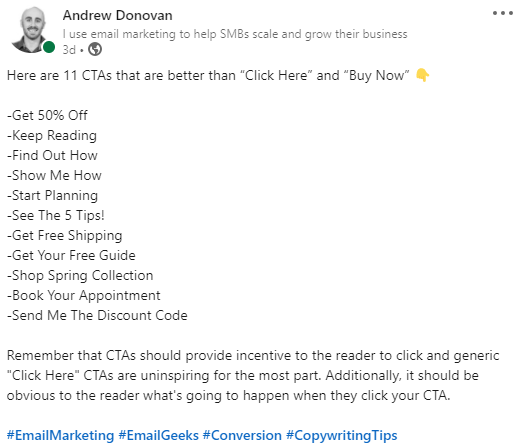- Thanks for Unsubscribing
- Posts
- Here's How To Write A Better Call To Action (CTA)
Here's How To Write A Better Call To Action (CTA)
Writing better CTAs begins with thinking of them as calls to VALUE, not ACTION.

Early on in my journey as a content marketer, I was told that while people hate to be told what to do in real life, they love being told what to do on the internet — especially when interacting with websites, emails, and ads.
This piece of advice immediately struck me as being true. If you run around the IRL world telling people to “Go here” and “Open that”, you’re going to piss a lot of people off. Conversely, if you aren’t explicit with your instructions online, people get lost and frustrated. In turn, you lose attention, credibility, and sales.
So…how do you get people to do what you want them to do in the most effective way possible?
Recently, on LinkedIn, I wrote about this very topic and provided 11 CTAs that are better than those generic “Click here” and “Buy now” prompts you see littering the interweb.

In these examples, I am speaking to the individual reader and switch between the first and third-person (Which works better is dependent on your specific audience, so make sure to A/B test these CTAs if you use them).
Turn Your CTAs into CTVs
Two days after making that post, Chase Dimond published an excellent reframing of the traditional CTA on his LinkedIn.
Chase suggested changing Calls to Action to Calls to Value (CTV).

“Tell them what they’re getting” is such simple and effective advice for writing CTVs.
In the examples provided, there is no guessing what’s going to happen when you click the button or hyperlinked text. Remember the IRL vs digital analogy at the beginning of this blog? CTVs accomplish this better than a traditional CTA.
Again, finding out what CTV works the best will come down to another marketing acronym (there are roughly infinity marketing acronyms): Always Be Testing (ABT).
Ask Yourself This One Question Before Writing A CTA/CTV
Recently, I was writing the copy for an email on behalf of a client and the CTA I wrote was “Add The [Product] To Cart”.
It’s not a bad CTA. It’s better than “Add To Cart” but perhaps not quite a CTV.
In any case, my editor came back to me with the following comment:
“When I click that CTA, I am brought to a product page where I still have to add the product to my cart. Consider adjusting for a better UX.”
That was a great point by my editor and I overlooked the disjointed user experience (UX) because I didn’t ask myself this one question:
Is it 100% obvious where the contact will go and what will happen if they click this CTA?"
The answer, in this case, was NO!
I told them that the button would add the product to their cart — it didn’t fulfil that promise so it needed to be changed.
I settled on the CTA “Purchase Your [Product]” because that’s what the product page will prompt them to do.
For this example, my CTA had to not only be more clear but also had to compliment the CTA on the landing page the contact was going to visit.
Don’t Overlook Your CTAs
Calls to action can be overlooked because they’re often short — one to five words — and come at the end of a block of text explaining how awesome a product or service is.
But imagine this:
You’re at a Porsche dealership waiting to buy the car of your dreams (In my case, it’s a 1990 Porsche 964 Cabriolet…though I’m not sure why a dealership would have a 32-year-old car in stock so let’s overlook that).
The salesperson does a bang-up job telling you how awesome this car is and you’re sold on purchasing it.
At the end of the spiel, the salesperson says, “Buy now!”
Uhh…pardon? Are we not going to talk about what colour I want? Warranty upgrades? Trim? Financing?
There’s no indication of direction or next steps or who I need to speak to, just a prompt for me to purchase.
How annoying!
Unfortunately, many digital businesses write their CTAs like this.
You need to guide your contact down through the buyer’s journey with as little friction and confusion as possible. That’s how you maximise ROI and that’s why you need to pay attention to how to write your CTAs and CTVs.
‘Til next time,Andrew